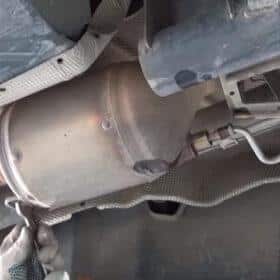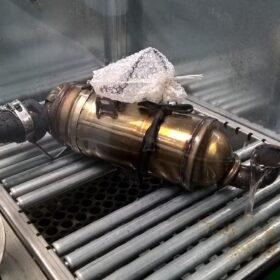Catalytic Treatment of Exhaust Systems
Thermal reactors were only a transitional arrangement for two reasons. The first is that it was difficult to obtain high oxidation rates without running the engine rich and using retarded spark timing, both of which were inefficient; the second was that it was not useful to control NOx. Hence, an alternative method of exhaust clean-up, the catalytic converter was introduced and this is now the most common method of exhaust emission control. This has the advantage that exhaust temperature can be kept moderately low and the engine parameters, compression ratio, and spark timing can be retained at levels which are optimized for the combustion factors alone and, hence, can provide the best efficiency for the air-fuel ratios used.
Catalytic converters use metallic catalysts to promote the desired reactions at lower temperatures than would otherwise be needed. Typical values are shown in Figure 8.21. The catalyst types could be a base metal (e.g., copper, Cu, or chromium, Cr) but are more usually noble metal (platinum, Pt, palladium, Pd, rhodium, Rh). The transition metal oxides of copper, cobalt, iron chromate, and vanadium are also useful as catalysts and have been considered. However, in spite of their expense, the noble metal types are commonly used as these have been found to be better catalysts. Reactors usually use some combination. The noble metals are preferred because:

Fig. 8.21. Typical conversion efficiencies at different temperatures for catalytic oxidation of HC and CO.
(data from Heywood [8])
- •
-
They are much less deactivated by sulphur in the fuel at temperatures < 500 °C.
- •
-
They have a higher specific activity for hydrogen oxidation.
- •
-
They can be made more thermally resistant to reduced low-temperature activity.
- •
-
They have a superior cold-start performance.
- •
-
They provide equivalent catalytic activation with smaller volumes than do base metals.
The amount of noble metal is kept small by plating on the surface of a pellet bed, ceramic honeycomb structure, or metal matrix. The pellet types originally used generally consisted of particles of approximately 3-mm diameter of a substance such as aluminium oxide (Al2O3). Because of their high-pressure drop, they have largely been replaced by the honeycomb or matrix types, which have an inside diameter of the sections of about 1 mm. Ceramic honeycombs now in use have wall thicknesses of about 0.15 mm with 62 cells/cm2 giving a flow area of about 70 percent of the cross-section. This compares with about 90 percent for metal types (Heck and Ferranto [59]), which have a lower pressure drop. They use a catalyst wash coat over the honeycomb based on γ-Al2O3 but which contains the catalyst materials of about 0.1 percent to 0.15 percent, 20 percent cerium oxide (CeO2), and stabilizers such as barium oxide (BaO). Rare earth and alkaline ions can improve stabilization (Church et al. [60]). The cerium oxide has the ability to store oxygen under lean conditions and return it to the flow under rich conditions and so extend the air-fuel ratio window at which the catalytic converter works (Padeste et al. [61]). The wash coat thickness may range from about 10 μm to 150 μm thick but is more commonly in the middle of that range at 20 μm to 60 μm (Heck and Farranto [59]). The largest metal mass is platinum, usually about five times that of the rhodium, although the ratio may vary considerably. Tests by Lox et al. [62] show that Pt-Rh catalysts and Rh-only catalysts have similar effectiveness, which is superior to Pt only. High-temperature performance may be enhanced by the appropriate combination of metals (Trimm [63]).
Flow through the converter may be either radial or axial but is usually the latter, as shown in Figure 8.22. The noble metal is at least partially recoverable at the end-of-life of the converter, a typical reclamation of about 90 percent being achievable using acidic solutions. This value varies little with the vehicle mileage and the degree of poisoning of the material that has taken place during its lifetime.
Fig. 8.22. Catalytic converter construction.
The catalyst efficiencies using the noble metals for oxidation are high at moderate temperatures. For example, a typical 90 percent oxidation of CO occurs at about 300 °C while for UHC the same level is reached at about 350 °C to 370 °C. The conversion efficiency falls to zero at about 150 °C to 200 °C, some 200°C lower than the thermal reactors. Best oxidation levels occur with lean mixtures (unless an air pump is used to provide additional air) as there is then sufficient oxygen available for oxidation in the normal exhaust gases. Catalyst efficiencies of 90 percent for UHC and 95 percent for CO are possible for air-fuel ratios that are either stoichiometric or lean.
The same catalyst materials also promote the reduction of NOx to N2 and O2. For reduction, the exhaust CO and any H2 (and UHC as these contribute to the CO) are used to remove the oxygen, perhaps directly or via a route which first produces N2O. The final products in the exhaust gases are N2, and CO2 and H2O. As CO is necessary for this process, it occurs much more efficiently when no oxygen exists in the exhaust gases, that is, when the mixture is rich. The noble metals of platinum and palladium are good catalysts for this reduction process, although again rhodium (Rh) is superior. This is because it produces less ammonia (NH3) which can be reconverted to NO. Base metals, such as copper oxide (CuO) and nickel oxide (NiO), will accelerate the reduction process catalytically but are less efficient than the noble metals. Nevertheless, Ni compounds have been used widely because of their ability to convert H2S to SO2 but there is concern in some countries regarding their health risks and they are being phased out (Cooper [64]). Typically, a peak conversion efficiency of around 90 percent occurs at air-fuel ratios from zero to about 0.5 percent richer than stoichiometric (Heywood [4]). As the mixture enriches further, a small reduction in conversion efficiency occurs, while for leaner mixtures the fall-off is rapid. For a mixture about 1.5 percent lean of stoichiometric, the conversion efficiency is down to about 20 percent. Thus, the use of catalytic converters for NOx reduction requires tight control of any lean-burn combustion.


